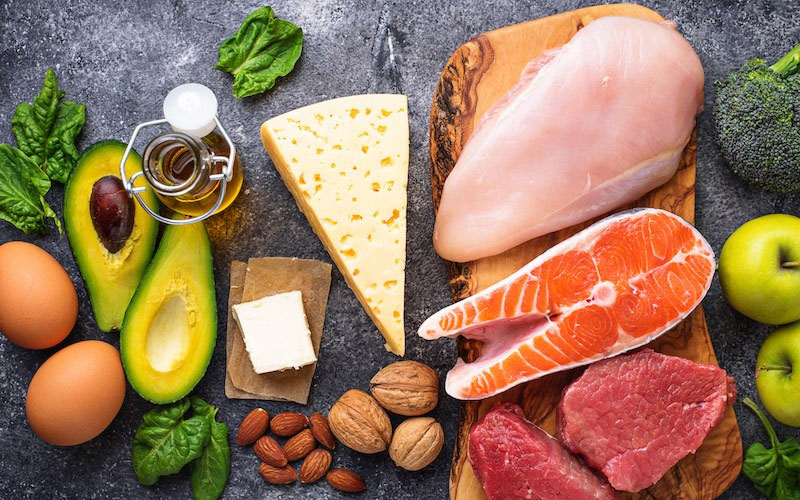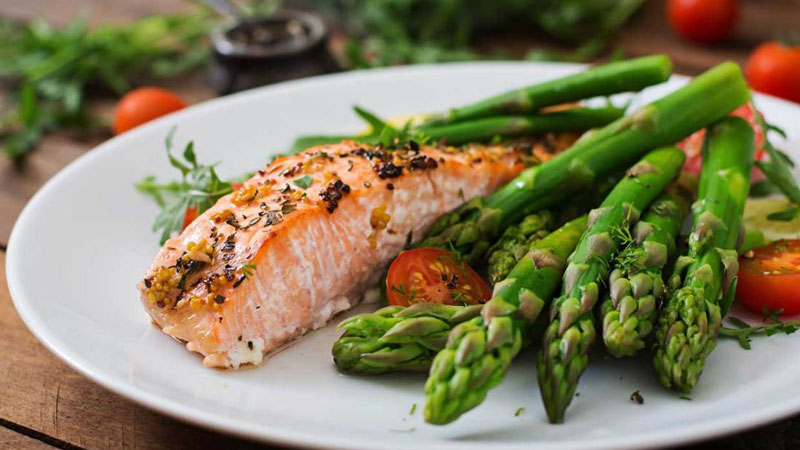
Using a low-carb diet can help you lose weight – when used as part of a calorie-controlled diet plan.
“What is a low carb diet?” That’s the question we often get asked at Greatest Physiques.
It’s simple really – a low carb diet is one where foods containing carbohydrates are taken out of the diet and replaced with other macronutrients, namely protein and fat.
In other words, grains such as pasta and rice are a no-no. Sugary snacks are removed from your plan altogether, and instead, there’s an emphasis on low-carb foods.
Want to know how a low-carb diet can work for you?
Read on to find out more…
Low-Carb Dieting: The Basics
A low-carb diet is one that purposely restricts carb-based foods such as grains, pasta and sugary foods.
The best way to start an article like this is to state very clearly… you will only lose weight if you are in a calorie deficit.
It’s only by taking in fewer calories than you burn off over time that you trigger the cellular changes that result in fat loss.
There’s nothing special about low-carb diets.
They aren’t magic and don’t work any better than low-fat diets when calories are equated.
But here’s the thing… many people find lower-carb diets make it easier to achieve their calorie deficit.
How many times have you gone crazy eating pasta?
Or gone overboard with the sweet treats in an evening?
Carbs are easy to overeat.
That’s why a lower-carb diet can work well for weight loss – because it can make it easier to curb the calories and reign in your sweet-toothed appetite.
And that makes it a viable dieting strategy for anyone wanting to ditch excess pounds and get leaner.
What are carbohydrates?
As a macronutrient, carbs provide energy – 4 kcal per gram.
At higher intensities, they are the primary fuel source used by the body to make ATP – the compound needed to fuel cells.
However, unlike protein and fats, carbs aren’t essential.
When your muscles and liver are low in glycogen (this is how carbs are stored in the body), protein can be used to make more through a process called gluconeogenesis – basically ‘the birth of carbs’.
Studies show that long-term adherence to low-carb diets can result in significant weight loss, if a calorie deficit is achieved [1].
However, it’s worth noting that short-term low-carb dieting leads to weight loss too.
Glycogen holds water. When you start a low-carb diet in the short-term, your muscles use up that stored glycogen quickly (dependent on your activity levels you’ll use up most of it in a few hours to a couple of days).
The knock-on effect is you’ll lose weight on the scales pretty fast, simply because you’ve lost glycogen and water.
It’s easy to mistake this for fat loss. It isn’t. But it’s still weight on the scales, which is important if you’re a weightlifter needing to make weight for example.
Different types of low-carb diet
There’s no specific way to go ‘low-carb’.
In fact, the very definition of low-carb means different things to different people.
This kind of diet has increased in popularity over the last few years. Although some types of low-carb approach are controversial, simple lower-carb diets are becoming more and more accepted in the scientific literate as a legitimate dietary approach.
And as such we’ve seen a boom in the number of dietary approaches using a lower carbohydrate plan.
- Low-carb, high-fat diets (LCHF) – a flexible diet where carbs are restricted, not eliminated.
- Atkins and eco-Atkins – the most well know low-carb diet, consisting of different phases where carb intake is manipulated to maximize fat loss. Eco-Atkins is a vegan-friendly approach to the same diet.
- Ketogenic – the aim of this diet is to restrict carbs so that the body enters a state of ‘ketosis’. Originally designed as a treatment for epilepsy, the keto diet forces the body to burn fat as fuel by targeting fatty acid stores.
- Paleolithic – based around foods that were available during the paleolithic era – essentially a diet of protein, vegetables and limited grains.
All of these diets utilize a low-carb approach. But do so in a way that’s specific to its own methodology.
For example, a LCHF diet sees you reduce your carb intake down to a manageable 150 g or lower, whereas the ketogenic diet suggests 50 g or less.
It’s about finding a diet that works for you; allowing you to reach your calorie while still fitting nicely into your lifestyle.
Key Point: The term ‘low-carb’ is quite flexible. There are a number of diets out there that manipulate carbohydrates to help you achieve a calorie deficit and therefore lose body fat.

Foods to Eat
The best way to approach your low-carb diet is to familiarize yourself with the foods you can (and can’t) eat. That way, you can control what goes in your mouth, and maximize your route to fat loss success.
Each diet will have its own guidelines. Some are aggressive, restrictive rules whereas others are more flexible and negotiable.
However, here’s a list of standard foods that most LC diets allow:
- Meat: high-protein diets help you maintain muscle mass when dieting. It’s always a good idea to add in foods such as chicken, turkey, beef and pork.
- Eggs: high in vitamin D3, protein and micronutrients, eggs are a real super food. They’re also high in cholesterol – the nutrient that makes testosterone.
- Vegetables: lower-calorie, high-nutrient vegetables can bulk out your diet. Carrots, beets, spinach, onion, bell peppers and broccoli are best.
- Nuts and seeds: although high in fats, nuts and seeds provide essential nutrients and calories. Almonds, cashews, pistachios and macadamia are great choices. Pumpkin seeds are a great source of zinc, which is essential for testosterone production.
- Dairy – foods such as milk, cheese, cream and yogurt provide high protein and a range of important minerals such as calcium which is important for muscle, nerve cell and bone health.
Additionally, some low-carb diets allow legumes, potatoes (usually sweet potatoes) and wholemeal rice and pasta.
Others don’t.
Coffee, tea, water and sugar-free sodas are allowed with all low-carb diets. Hydration is important – so make sure these are regularly added to your diet on a daily basis.
To some extent, there’s potential to ‘build your own’ low-carb diet. And ultimately, if it works, it works.

Foods to Avoid
It might sound simple – ‘Just avoid carbohydrates’, right?
There’s more to a low-carb diet than you might think.
Here are the foods you need to restrict or avoid:
- Sugary foods – anything that has added sugar. That includes candy, soda, cookies, frozen yogurt etc.
- Fruit juice – because the fiber’s been removed, fruit juice can spike blood sugar much faster.
- Refined grains – processed grains such as white rice, pasta, breakfast cereals and bread.
- Diet foods – packaged foods that claim they’re ‘diet’ do have lower fat content, but often contain added sugar to maintain flavor.
- Fruits and starchy vegetables – on some very low-carb diets you’ll need to restrict fruit and vegetable intake too.
Having a list of foods you can and can’t eat is important.
A framework of guidelines helps you make informed food choices. This is especially important when you’re on the go and need to grab a quick snack without deviating from the plan.
Key Point: Being aware of foods you can and can’t eat on a low-carb diet helps make your journey more successful.
Health Benefits
Focusing your attention on lean proteins, healthy fats and plenty of vegetables provides several metabolic and vascular benefits.
As low-carb diets become more and more popular, scientists are increasingly interested in the benefits that they provide.
Better metabolic health
Diabetes and high cholesterol are huge issues in the Western world. The number of diabetics for example has increased from 108 million to 422 million over 30 years [2]. That’s 8.5% of the adult population.
Studies show that low-carb diets can be effective for managing blood sugar, improving the way your body uses insulin to regulate glucose levels [3, 4].
There also appears to be a strong link between lower-carbohydrate diets and lipid profile too.
For example, studies have shown that following a LCHF diet leads to decreased blood triglyceride levels [5].
And other studies show an increase in ‘healthy’ HDL cholesterol [6].
This is great news for both vascular and overall metabolic health. When combined with regular exercise, this essentially ‘bulletproofs’ your heart and arteries.
Weight loss
Again, low-carb diets only result in weight loss when a calorie deficit occurs. But as a real world tool, reducing carbohydrate intake appears to lead to significant weight loss – particularly belly fat.
We’ve already said that short-term low-carb diets lead to glycogen and water loss [7]. This has a huge effect on your scale weight.
Okay, it’s not fat loss, but if you want to drop a few pounds in a day or two for a fight weigh-in or to just feel better about yourself for a big social occasion, low-carb is useful.
An increase in central adiposity leads to insulin resistance, liver problems and eventually an increase in diabetes and heart disease risk [8]. This kind of body fat stores itself in and around your internal organs, leading to high levels of inflammation and ill health.
Low-carb diets have a positive effect on reducing ‘belly fat’ [9]. It appears to be an effective intervention, not just for obesity, but also overall health and wellness.
Appetite regulation
In order to achieve a calorie deficit, it’s important you control your energy intake. The hardest part of dieting is curbing hunger and regulating appetite.
A low-carb diet helps you control your appetite by allowing higher levels of protein – the most satiating of the three macronutrients.
Studies show that a low-carb diet helps to boost mood, reduce food cravings and even increase energy levels [10].

Side Effects of a Low-carb diet
Although there are numerous benefits to ditching carbohydrates, it’s important you weigh up the potential disadvantages too.
Low-carb diets don’t suit everyone.
For every person that shreds fat and hits single-digit leanness, there’s another person that suffers ill health.
If you’re unsure whether a low-carb diet will suit you, speak to your health practitioner or doctor and get their advice.
It’s all about weighing up your options and deciding which diet works best for you.
Here are a few side effects to look out for:
- Brain fog
- Poor athletic performance
- Poor sleep and mood
- Lack of energy
- Heart palpitations or anxiety
- Nausea, stomach upset and headaches
- Bad breath
- Muscle cramps
Key Point: Low-carb diets aren’t for everyone. Be aware of any negative side effects and watch out for any adverse reactions.
Meal Plans
Check out this 7-day low-carb diet meal plan to shred body fat and improve health.
Monday
- Breakfast: Greek yogurt with whey protein powder. 2 egg omelette with mushrooms
- Lunch: Chicken salad with mixed vegetables and pine nuts
- Evening meal: Salmon fillet with broccoli and asparagus
Tuesday
- Breakfast: Bacon and avocado with pomegranate
- Lunch: Shrimp, walnut and zucchini salad
- Evening meal: Steak, eggs and mixed vegetables
Wednesday
- Breakfast: Spinach and tomato frittata
- Lunch: Avocado and berry smoothie with full fat milk
- Evening meal: Chili con carne with cauliflower rice
Thursday
- Breakfast: Yogurt and raspberries with zero-sugar syrup
- Lunch: Flaked chili salmon with zucchini noodles
- Evening meal: Egg noodle lasagne
Friday
- Breakfast: Ham and cheese in zucchini boats
- Lunch: Vegetables soup
- Evening meal: Lamb curry with cauliflower rice
Saturday
- Breakfast: Yogurt with chia seeds and blueberries
- Lunch: Feta, cheese and onion stuffed bell peppers
- Evening meal: Pork meatballs in spicy passata with roasted root vegetables
Sunday
- Breakfast: Coconut flakes with apple slices
- Lunch: Bunless burger and salad
- Evening meal: Grilled garlic and lemon chicken with green beans
Top Tips and Tricks
Diet success all comes down to planning. Use these hints and tips to stay on top of your low-carb weight loss mission.
Here are our top tips for following a low-carb diet:
- If you’re eating at a restaurant, order a meat or fish-based meal with a side of vegetables. Avoid bread and rice and skip the soda unless it’s sugar-free.
- Stock up on recipe ideas. Keep things interesting and enjoyable and you’re much more likely to stick to your diet.
- Plan your meals in advance. That way you’ll be sure to have the ingredients you need and less likely to stray from what’s recommended.
- Make protein the base of each meal. It’s good for muscle maintenance but also boosts feelings of fullness.
- Have the odd ‘cheat day’. Having an occasional treat helps to boost motivation and adherence. It also helps to fill your energy levels and muscle glycogen too.
Key Point: A big part of low-carb dieting is planning. Using these simple tips helps to keep you on track and makes that journey to better body composition that little bit easier.
Key Takeaway
A high-carb Western diet can lead to obesity and disease when taken to excess. Utilizing a low-carb diet is a great way to achieve the calorie deficit needed to trigger weight loss.
Make list of low-carb foods and a meal plan that suits your lifestyle and taste and you’re well on your way to a fitter, leaner more confident you.
References
[1] Foster, GD et al. A Randomized Trial of a Low-Carbohydrate Diet for Obesity. New Engl J Med. 2003; 348: 2082-2090
[2] Sarwar, N et al. Diabetes mellitus, fasting blood glucose concentration, and risk of vascular disease: a collaborative meta-analysis of 102 prospective studies. Lancet. 2010 Jun 26;375(9733):2215-22
[3] Noakes, M et al. Comparison of isocaloric very low carbohydrate/high saturated fat and high carbohydrate/low saturated fat diets on body composition and cardiovascular risk. Nutr Metab. 2006. 11; 3: 7
[4] Tay, J et al. Comparison of low- and high-carbohydrate diets for type 2 diabetes management: a randomized trial. Am J Clin Nutr. 2015; 102(4): 780-90
[5] Aude, Y et al. The National Cholesterol Education Program Diet vs a Diet Lower in Carbohydrates and Higher in Protein and Monounsaturated Fat. JAMA. 2004; 164(19): 2141-2146
[6] Brinkworth, GD et al. Long-term effects of a very-low-carbohydrate weight loss diet compared with an isocaloric low-fat diet after 12 mo. Am J Clin Nutr. 2009; 90(1): 23-32
[7] D’Anci, K et al. Low-carbohydrate weight-loss diets. Effects on cognition and mood. Appetite. 2009; 52(1): 96-103
[8] Fan, H et al. Abdominal obesity is strongly associated with Cardiovascular Disease and its Risk Factors in Elderly and very Elderly Community-dwelling Chinese. Sci Rep. 2016; 6
[9] Volek, J et al. Comparison of energy-restricted very low-carbohydrate and low-fat diets on weight loss and body composition in overweight men and women. Nutr Metab. 2004; 8(1): 13
[10] McClernon, FJ et al. The effects of a low-carbohydrate ketogenic diet and a low-fat diet on mood, hunger, and other self-reported symptoms. Obesity. 2007; 15(1): 182-7





Comments are closed